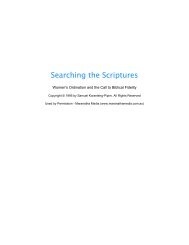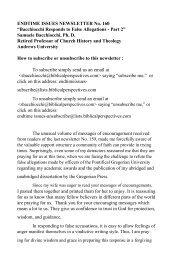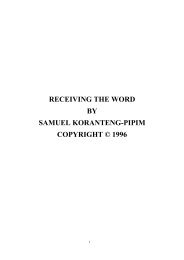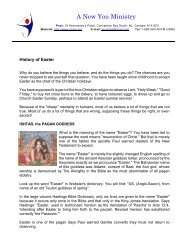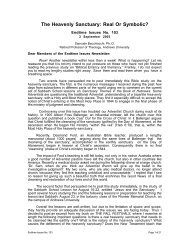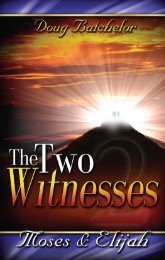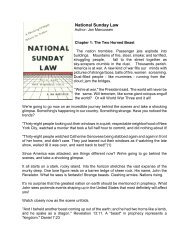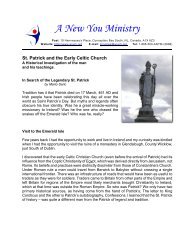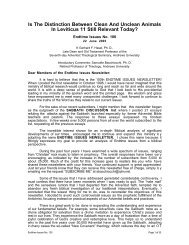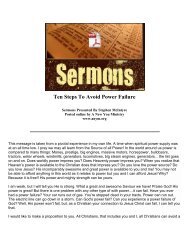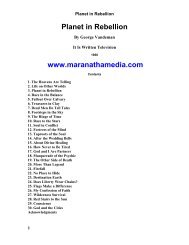Bible Readings for the Home Circleâ1914 - A New You Ministry
Bible Readings for the Home Circleâ1914 - A New You Ministry
Bible Readings for the Home Circleâ1914 - A New You Ministry
Create successful ePaper yourself
Turn your PDF publications into a flip-book with our unique Google optimized e-Paper software.
BIBLE READINGS<br />
this outline in <strong>the</strong> history of <strong>the</strong> world since <strong>the</strong> time of Nebuchadnezzar<br />
constitutes an unimpeachable testimony to <strong>the</strong> inspiration of <strong>the</strong>se<br />
prophecies, and furnishes a ground of confidence that <strong>the</strong> unfulfilled<br />
portion of <strong>the</strong> prophecies will be wrought out in <strong>the</strong> future with absolute<br />
certainty and in every detail.<br />
THE VICAR OF CHRIST<br />
{224<br />
224}<br />
1. WHAT appeared unto Daniel in 538 B.C., <strong>the</strong> same year in which<br />
Babylon fell<br />
“In <strong>the</strong> third year of <strong>the</strong> reign of King Belshazzar a vision appeared<br />
unto me, even unto me Daniel, after that which appeared unto me at <strong>the</strong><br />
first.” Dan. 8:1.<br />
2. Where was Daniel at this time<br />
“And I saw in a vision; and it came to pass, when I saw, that I was at<br />
Shushan in <strong>the</strong> palace, which is in <strong>the</strong> province of Elam; and I saw in a<br />
vision, and I was by <strong>the</strong> river of Ulai.” Verse 2.<br />
3. What first attracted <strong>the</strong> prophet’s attention<br />
“Then I lifted up mine eyes, and saw, and, behold, <strong>the</strong>re stood be<strong>for</strong>e<br />
<strong>the</strong> river a ram which had two horns: and <strong>the</strong> two horns were high; but<br />
one was higher than <strong>the</strong> o<strong>the</strong>r, and <strong>the</strong> higher came up last.” Verse 3.<br />
4. What power was represented by <strong>the</strong> ram having two horns<br />
“The ram which thou sawest having two horns are <strong>the</strong> kings of Media<br />
and Persia.” Verse 20.<br />
5. How are <strong>the</strong> rise and work of this power described<br />
“I saw <strong>the</strong> ram pushing westward, and northward, and southward; so<br />
that no beasts might stand be<strong>for</strong>e him, nei<strong>the</strong>r was <strong>the</strong>re any that could<br />
deliver out of his hand; but he did according to his will, and became great.”<br />
Verse 4.<br />
6. What symbol was next introduced in <strong>the</strong> vision<br />
“And as I was considering, behold, an he goat came from <strong>the</strong> {225<br />
225}<br />
west on <strong>the</strong> face of <strong>the</strong> whole earth, and touched not <strong>the</strong> ground: and <strong>the</strong><br />
goat had a notable horn between his eyes.” Verse 5.<br />
7. What did <strong>the</strong> goat with <strong>the</strong> notable horn represent<br />
“And <strong>the</strong> rough goat is <strong>the</strong> king of Grecia: and <strong>the</strong> great horn that is<br />
between his eyes is <strong>the</strong> first king.” Verse 22.<br />
8. How was <strong>the</strong> conquest of Medo-Persia by Grecia <strong>for</strong>etold in this<br />
THE VICAR OF CHRIST<br />
symbolic prophecy<br />
“And I saw him come close unto <strong>the</strong> ram, and he was moved with<br />
choler against him, and smote <strong>the</strong> ram, and brake his two horns: and <strong>the</strong>re<br />
was no power in <strong>the</strong> ram to stand be<strong>for</strong>e him, but he cast him down to <strong>the</strong><br />
ground, and stamped upon him: and <strong>the</strong>re was none that could deliver <strong>the</strong><br />
ram out of his hand.” Verse 7.<br />
9. When <strong>the</strong> he goat “was strong,” what occurred<br />
“There<strong>for</strong>e <strong>the</strong> he goat waxed very great: and when he was strong,<br />
<strong>the</strong> great horn was broken; and <strong>for</strong> it came up four notable ones toward <strong>the</strong><br />
four winds of heaven.” Verse 8.<br />
10. Who was represented by “<strong>the</strong> great horn,” and what followed<br />
when it was broken<br />
“And <strong>the</strong> rough goat is <strong>the</strong> king [kingdom] of Grecia: and <strong>the</strong> great<br />
horn that is between his eyes is <strong>the</strong> first king. Now that being broken,<br />
whereas four stood up <strong>for</strong> it, four kingdoms shall stand up out of <strong>the</strong><br />
nation, but not in his power.” Verses 21, 22.<br />
NOTES.— From <strong>the</strong> interpretation given, it is plain that <strong>the</strong> notable<br />
“horn” upon <strong>the</strong> he goat represented Alexander <strong>the</strong> Great, who led <strong>the</strong><br />
Grecian <strong>for</strong>ces in <strong>the</strong>ir conquest of Medo-Persia. Upon <strong>the</strong> death of<br />
Alexander at Babylon, B.C. 323, <strong>the</strong>re followed a brief period of confusion<br />
in <strong>the</strong> struggle <strong>for</strong> <strong>the</strong> kingdom, but <strong>the</strong> succession was definitely<br />
determined by <strong>the</strong> battle of Ipsus, B.C. 301. Alexander’s four leading<br />
generals—Cassander, Lysimachus, Ptolemy, and Seleucus—became<br />
his successors.<br />
“The vast empire created by Alexander’s unparalleled conquests<br />
was distracted by <strong>the</strong> wranglings and wars of his successors, and<br />
be<strong>for</strong>e <strong>the</strong> close of <strong>the</strong> fourth century be<strong>for</strong>e Christ, had become broken<br />
up into many fragments. Besides minor states, four well-defined<br />
and important monarchies rose out of <strong>the</strong> ruins. . . . Their rulers were<br />
Lysimachus, Cassander, Seleucus Nicator, and Ptolemy, who had each<br />
assumed <strong>the</strong> title of king. The great horn was broken; and instead of it<br />
came up four notable ones toward <strong>the</strong> four winds of heaven.” Myers’s<br />
“History of Greece,” page 457, edition 1902.<br />
11 What came out of one of <strong>the</strong> four horns of <strong>the</strong> goat<br />
“And out of one of <strong>the</strong>m came <strong>for</strong>th a little horn, which waxed exceeding<br />
great, toward <strong>the</strong> south, and toward <strong>the</strong> east, and toward <strong>the</strong><br />
pleasant land.” Verse 9. {226<br />
226}<br />
12. What interpretation is given to this little horn<br />
“And in <strong>the</strong> latter time of <strong>the</strong>ir kingdom, when <strong>the</strong> transgressors are<br />
come to <strong>the</strong> full, a king of fierce countenance, and understanding dark<br />
sentences, shall stand up.” Verse 23.<br />
13. What did this little horn do to <strong>the</strong> people of God




